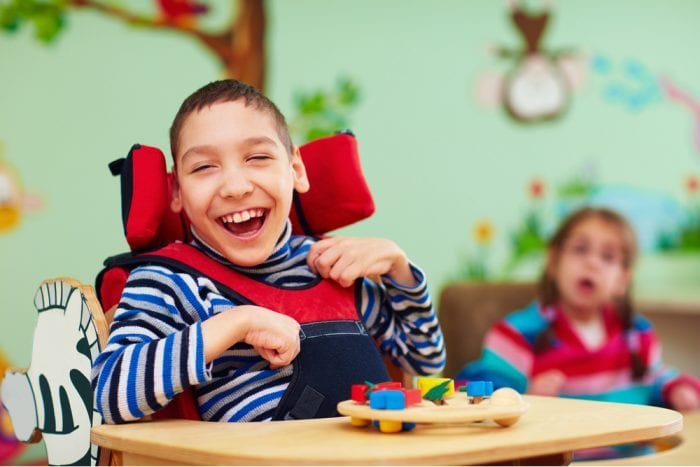Cannabis shows great promise in improving speech, dealing with pain, and reducing the spasticity of cerebral palsy.
Cerebral Palsy (CP) is a neurological disorder that affects movement and muscle control. The most common symptoms of CP are muscle stiffness and spasticity, pain, drooling, and speech difficulty. One of the causes of CP is early brain injury. This can happen either to the child in utero, during childbirth, or as an infant.
Because cannabis is an effective treatment for pain, many CP patients or their caregivers are interested in using cannabis to treat the pain associated with the muscular issues of CP. In addition, cannabis is thought to have other pharmacological effects. These could help CP patients with some of their other symptoms like muscle spasticity, seizures, and speech issues.
There are very few clinical studies of cannabis or cannabinoids on CP itself. However, there is substantial clinical evidence for some of the symptoms that may accompany CP. For example, some CP patients are prone to seizures, and cannabidiol (CBD), one of the major phytocannabinoids produced by Cannabis sativa, can effectively reduce the frequency and severity of seizures in children with severe forms of epilepsy.
Remember, speak to your doctor before giving your children any type of medicine, especially cannabis, which can affect the developing brain.

Can Pain of Cerebral Palsy be Managed by Cannabis?
Pain often goes hand in hand with muscular issues in CP. One study surveyed adults with CP in order to determine the effectiveness of their pain medications. Fewer than 5% of the survey respondents reported using marijuana to treat their CP pain, but these did report that it was very effective, with an effectiveness rating similar to that of more traditional pain relievers like opioids or ibuprofen. There are numerous studies on the efficacy of delta-9-tetrahydrocannabinol (THC) as an analgesic (pain reliever) especially in difficult cases of chronic pain.
There is some preliminary evidence that cannabis could help to improve speech issues. One case study involving two individuals with Tourette’s syndrome finds that cannabis helps them speak more fluidly. Most importantly, CBD helps them overcome speech tics. There is also anecdotal evidence of cannabis helping individuals with cerebral palsy to overcome stuttering and other speech impediments. Further clinical research could confirm this effect.

Cannabis for Muscle Spasticity
Scientists are currently studying the use of cannabis to treat the muscle spasticity in CP as well as in other diseases like multiple sclerosis (MS). A phase 2 clinical study finished in early 2017. This study analyzed the use of an oromucosal spray with a 50:50 ratio of THC to CBD (called Sativex). A news release from the pharmaceutical company that manufactures Sativex, GW Pharmaceuticals, indicates that there are no statistically significant differences in muscle spasticity between CP patients taking the drug and the placebo group. However, Sativex effectively treats the spasticity of MS. This underscores our need for more research into cannabinoids treating the muscle spasticity of CP.
Is Cannabis Able to Prevent Cerebral Palsy?
In addition to the symptoms, there is some evidence that cannabinoids could impact the outcomes for CP. For example, recent data shows that the endocannabinoid system, including the cannabinoid receptors CB1 and CB2 and the endogenous cannabinoid anandamide, helped to protect the brain in newborn mice from developing lesions that lead to CP. Lesions like these are one of the contributing factors to the development of CP in humans, as well. We need to study this more deeply. Mostly to ensure that prenatal or postnatal treatment with endocannabinoids will not have a negative developmental impact. This is especially true because the cannabinoid system plays such a critical role in human brain development. Helpful or harmful for developing humans – the research is not there yet.
There are very few clinical studies on the use of cannabis or cannabinoids to effectively manage the symptoms of cerebral palsy. However, the successful use of cannabis for treating other conditions – like pain, spasticity, and seizures – could be extrapolated with caution to the management of these same symptoms in patients with cerebral palsy.
Methods of Administration for Cerebral Palsy
In some cases, absorption methods like patches could benefit patients with CP. These would negate issues surrounding chewing and swallowing. Medibles would last the longest, and quick absorption methods like vaping or smoking could provide relief the fastest. A volcano vaporizer, with a bag attachment, may be one of the best ways to administer cannabis for someone with CP.
Further, if the consumer is worried about smoking, know that vaping dry bud is an option. Further, dry bud vaping is free from the concerns of the EVALI crisis of late 2019. And, vaping dry bud also removes any concerns about combustion via smoking.




dawn. green
I really would like more information about Chrones and the working of CBD. I have chrones and finally gave up on the expensive Pharmacy medication that did not work.And went on CBD.It has helped me to live and work with this. horrible disease.
Jennifer Grant
We’ll work on that article then. Thanks for the feedback.
Nnonye Obi
My baby just clocked one last weekend.Doctors said she has evolving CP.But presently she jerks and cries .She is on Tegretol ,Efamol,Osteocare and Baclofen.Is it advisable to give her this oil ? What dose should I begin with ?